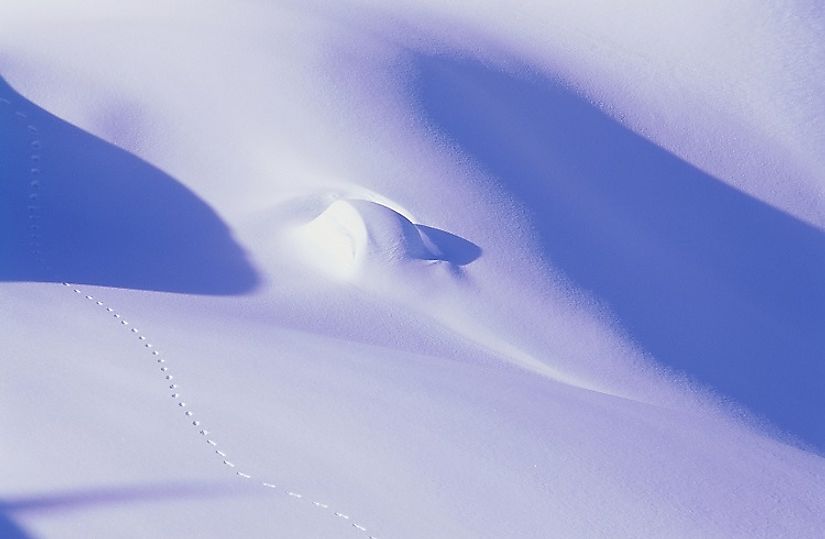Where Is The Arctic Desert?

5. Description
Depending upon the context, the Arctic Desert may refer to the larger Arctic region that receives little precipitation of any form, or in the context of detailing a collection of three North Pole islands located above 75 degrees North Latitude. Those islands are Novaya Zemlya, Franz Josef, and Severnaya Zemlya, but for the usage herein, we will generally look at the broader, dry Arctic region. Annually, this area, including the aforementioned islands, receive less than 10 inches of precipitation (counting both rain and snow), an amount similar to the Sahara Desert. The 62,300 square miles of the Arctic is a cold desert, though when snow does fall, it generally never melts, but instead remains year-round to cover the land surface. As the cold Arctic air is unable to hold much moisture, it therefore doesn’t rain or snow very often here, making for desert conditions. As a result, the air is dry in the Arctic just as it would be in a conventional "hot" desert, even though there is an ocean at the Arctic.
4. Historical Role
In the region now occupied by the Arctic Desert, throughout earth’s history the climate here has varied between periods of being much warmer and sustained, much colder, spells called Ice Ages, according to the Arctic Studies Center (ACS). An ice age has periods of warmer weather called inter-glacial lasting between 10,000 and 40,000 years, and periods of intense cold (glaciations). The latter are the times that cause glaciers to advance to the northern parts of continents well to the south of the Arctic. The last of these glacial periods ended 10,000 years ago, according to ACS. Arctic inhabitants, such as the Eskimos, have lived there for thousands of years, with the earliest known humans having lived there some 40,000 years ago in Western Siberia. On the Northern America side of the Arctic, human settlement began 15,000 years ago in what is now Alaska. For Greenland and Canada, Arctics human settlements, according to researchers, first began to emerge around 4,000 years ago.
3. Modern Significance
Tourism into the Arctic desert has been rising in recent years. Visitors to the desert get to see animal and plant species unique to its ecosystems. There also are lakes and streams where recreational activities go on. Some of the activities include sea cruises, boating, sport fishing, mountaineering, hunting excursions, rafting, hiking, dog sledding, skiing, snowshoe walks, and many others. The failure of the sun to set during the Arctic summer is another reason for tourists to visit the Arctic Desert to experience that surreal phenomenon. That is followed by an equally long season wherein the sun doesn’t rise. Tourists also get to experience the Eskimo culture when visiting their settlements. The Arctic Desert, being a polar region, also plays a key role in regulating the earth’s climate, according to the World Wildlife Fund.
2. Habitat and Biodiversity
There are various species of plants and animals that have adapted to survive at the Arctic desert. The Arctic tundra has about 1,700 plant species, including flowering plants, dwarf shrubs, herbs, grasses, mosses, and lichens. Tundra vegetation is generally comprised tiny plants only a few centimeters in height, and these generally grow together in huddles. Such huddles may specifically include include Cotton grass, Arctic poppies, Purple saxifrages, Bearberries, Pasque flowers, and Arctic willows. To sustain them, the tundra has permafrost, a layer of soil and partially decomposed organic matter that remains frozen all year-round. In this landscape, only a thin, active soil layer exists, and it defrosts and refreezes. That process stops larger vegetation like trees from growing in the Arctic Desert. There also are wild animals, like the Polar bear, Arctic fox, Greenland whale, narwhal, Beluga whales, walrus, Ringed lemming, Greenland seals, Bearded seals, and reindeer, to be found in various places therein.
1. Environmental Threats and Territorial Disputes
The human population in and around the Arctic Desert is low, and hence development-related environmental degradation is not an issue. The most pronounced threat comes from fossil fuel exploration locally, and the use of the same globally. When burned up, these fuels pollute and enhance global warming, which threatens to upset this fragile ecosystem. As the planet's temperatures rise, the permafrost also warms up and decays, causing more Carbon Dioxide to be released into the environment, according to a report by Marietta College. Global warming is also causing the polar ice caps to melt in the Arctic Desert, causing sea levels to rise and raising the flooding threats to low-lying levels around the globe. The melting of these ice caps is also threatening the lives of native Polar bears. Since they must hunt on ice, they can’t hunt effectively where ice has melted, and they die from drowning trying to swim the Arctic waters between their ever-more-distant sea ice hunting grounds. Furthermore, their orphaned cubs have even lower survival rates as they are left to fend for themselves, according to Polar Bears International.











